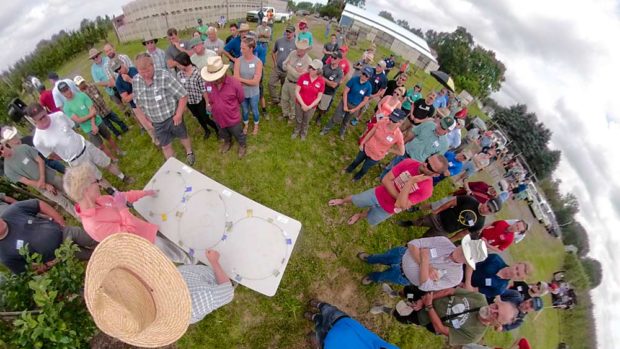
Almost 100 New York growers gathered in Niagara County on Thursday for a field day organized by Cornell Cooperative Extension’s Lake Ontario Fruit Program. Stops at three farms revealed a wide variety of systems, and growers shared insight from experiments into the best way to make orchards more productive and efficient.
At David Tower’s farm near the Ontario border, he showed attendees two multileader trials: Galas on Malling 26 roots planted at a 45-degree angle with four upright leaders each, selected from suckers and trained vertically; and Snapdragon on M.26 planted with four evenly spaced leaders trained from a vertical trunk.
“I wanted a high-density system, but you can’t plant a single stem on M.26 without it looking like a forest,” Tower said, explaining his approach to the planting. “Gala’s pretty forgiving, they are aggressive growers and they seem to be doing quite well without Apogee.”
In the long term, Tower hopes the resulting two-dimensional system will be easier to manage with mechanical pruning. It saved on tree costs up front, but the training in the first few years has been labor and learning intensive.
“I want to emphasize that this is four times more work,” said Cornell Cooperative Extension horticulturist Mario Miranda Sazo. There’s a lot more shoots per acre than a typical tall spindle system and they all need to stay in balance, he said.
Keeping the leaders in balance was also a topic at the second stop, where husband-and-wife growers Mark Russell and Jill MacKenzie shared details on the establishment of a first-leaf Honeycrisp block. They planted feathered nursery trees, but then cut back almost all the lower branches to drive vertical growth in the first year, MacKenzie said.
‘It was lots of work, but it was straightforward, so it was quick,” she said of the establishment pruning.
To make the block picker-friendly, they designed the system with windows — tree spaces left unplanted — throughout the block, and once the trees grow a little bit taller, they plan to remove the 4-foot trellis wire to make the system more pedestrian.
“I’m not waiting for robots,” Russell said of his training system and his goal to have a more two-dimensional canopy. “Anything that’s going to be easier for a robot to pick is also going to make my workers happy.”
He also described his decision to test out an alternate row spraying program, which he credits with saving four days of tractor driving but also may be responsible for the fact that the trees had more apples on one side after a lopsided chemical thinning program. Water-sensitive papers placed strategically in the canopy allow Russell, and tour attendees, to understand the spray deposition he’s getting.
The last stop on the tour was at Russell Farms, near Olcott, where grower Max Russell talked about the management of a 2016 planting of New York 2, which is marketed as RubyFrost. It’s been relatively easy to grow and is performing well for him, he said.
“We’d be willing to plant more, but we don’t want to plant apples we can’t sell for the price we need,” he said.
Cornell horticulturist Terence Robinson noted that the NY 2 planted on Budagovsky 9 roots was lagging behind those planted on M.9-337. He urged growers to consider a more vigorous choice from the Geneva rootstock series, G.969, for future plantings of NY 1, sold as SnapDragon, which is also weak growing, and NY 2 as well.
“It’ll push the trees up to the top of the trellis in two to three years and then it’s just crop after crop after crop,” he said. “If you are going to plant NY 1 and 2, it would benefit from a little push, as we can see here.”
—by Kate Prengaman






Leave A Comment